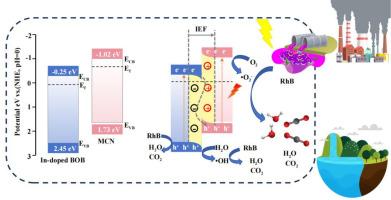通过集成in掺杂BiOBr和介孔C3N4构建s型异质结以增强光催化性能
IF 5.1
3区 材料科学
Q2 MATERIALS SCIENCE, COATINGS & FILMS
引用次数: 0
摘要
s型异质结光催化剂因其有效的电荷分离和强氧化还原性能而受到高度重视,在污染物修复中具有广阔的应用前景。本研究通过直接的钙钛矿转化方法成功制备了掺杂BiOBr (BOB)/介孔g-C3N4 (MCN)异质结。与纯BOB相比,掺杂的BOB在降解罗丹明B (RhB)方面表现出优越的光催化性能。这种改进归功于增强的光收集能力,增加的电荷分离和有效的界面电荷转移。在模拟阳光下,in掺杂的BOB/MCN复合材料在5 min内对RhB (20 mg·L−1,20 mL)的降解率达到了99%,优于BOB和MCN。观察到的增强是由于In掺杂的协同效应和s型异质结的形成。此外,in掺杂的BOB/MCN表现出优异的稳定性。通过广泛的表征技术(包括XPS和EPR)验证了S-scheme电荷转移途径,证实了光诱导电荷载流子的有效分离和高活性氧化还原电子-空穴对的保留。该研究为开发新型s型光催化剂提供了一个简单的策略,为环境应用和光催化领域的发展提供了有价值的见解。本文章由计算机程序翻译,如有差异,请以英文原文为准。

Constructing an S-scheme heterojunction by integrating In-doped BiOBr with mesoporous C3N4 for enhanced photocatalytic performance
S-scheme heterojunction photocatalysts are highly regarded for their effective charge separation and strong redox properties, making them promising for pollutant remediation. This study successfully developed In-doped BiOBr (BOB)/mesoporous g-C3N4 (MCN) heterojunctions through a straightforward perovskite transformation method. The In-doped BOB demonstrated superior photocatalytic performance in the degradation of Rhodamine B (RhB) compared to pure BOB. This improvement is attributed to enhanced light-harvesting capabilities, increased charge separation, and efficient interfacial charge transfer. Under simulated sunlight, the In-doped BOB/MCN composite achieved a remarkable 99 % degradation of RhB (20 mg·L−1, 20 mL) within 5 min, outperforming both BOB and MCN. The observed enhancement is due to the synergistic effects of In doping and the formation of the S-scheme heterojunction. Furthermore, In-doped BOB/MCN demonstrated excellent stability. The S-scheme charge transfer pathway was validated through extensive characterization techniques, including XPS and EPR, which confirmed the effective separation of photoinduced charge carriers and the retention of highly active redox electron-hole pairs. This research offers a straightforward strategy for developing novel S-scheme photocatalysts, providing valuable insights for environmental applications and advancing the field of photocatalysis.
求助全文
通过发布文献求助,成功后即可免费获取论文全文。
去求助
来源期刊

Diamond and Related Materials
工程技术-材料科学:综合
CiteScore
6.00
自引率
14.60%
发文量
702
审稿时长
2.1 months
期刊介绍:
DRM is a leading international journal that publishes new fundamental and applied research on all forms of diamond, the integration of diamond with other advanced materials and development of technologies exploiting diamond. The synthesis, characterization and processing of single crystal diamond, polycrystalline films, nanodiamond powders and heterostructures with other advanced materials are encouraged topics for technical and review articles. In addition to diamond, the journal publishes manuscripts on the synthesis, characterization and application of other related materials including diamond-like carbons, carbon nanotubes, graphene, and boron and carbon nitrides. Articles are sought on the chemical functionalization of diamond and related materials as well as their use in electrochemistry, energy storage and conversion, chemical and biological sensing, imaging, thermal management, photonic and quantum applications, electron emission and electronic devices.
The International Conference on Diamond and Carbon Materials has evolved into the largest and most well attended forum in the field of diamond, providing a forum to showcase the latest results in the science and technology of diamond and other carbon materials such as carbon nanotubes, graphene, and diamond-like carbon. Run annually in association with Diamond and Related Materials the conference provides junior and established researchers the opportunity to exchange the latest results ranging from fundamental physical and chemical concepts to applied research focusing on the next generation carbon-based devices.
 求助内容:
求助内容: 应助结果提醒方式:
应助结果提醒方式:


